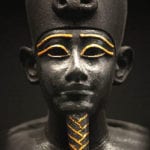 Movies and TV
Movies and TV  Movies and TV
Movies and TV  History
History 10 Things You Never Knew About Presidential First Ladies
 Movies and TV
Movies and TV 10 Zombie Movies That Will Actually Terrify You
 Humans
Humans 10 Times Scientists Were Absolutely Sure… and Absolutely Wrong
 Our World
Our World 10 Pivotal Moments for Life on Earth
 Movies and TV
Movies and TV 10 Most Realistic Medical TV Shows of All Time
 Creepy
Creepy 10 Eerie & Mysterious Ghosts of the Pacific Coast
 Weird Stuff
Weird Stuff 10 Typos That Accidentally Changed History
 History
History 10 Times Trickery Won Battles
 Technology
Technology 10 Awesome Upgrades to Common Household Items
 Movies and TV
Movies and TV 10 Movie Flops That Found Their Way to Cult Classic Status
 History
History 10 Things You Never Knew About Presidential First Ladies
 Movies and TV
Movies and TV 10 Zombie Movies That Will Actually Terrify You
Who's Behind Listverse?

Jamie Frater
Head Editor
Jamie founded Listverse due to an insatiable desire to share fascinating, obscure, and bizarre facts. He has been a guest speaker on numerous national radio and television stations and is a five time published author.
More About Us Humans
Humans 10 Times Scientists Were Absolutely Sure… and Absolutely Wrong
 Our World
Our World 10 Pivotal Moments for Life on Earth
 Movies and TV
Movies and TV 10 Most Realistic Medical TV Shows of All Time
 Creepy
Creepy 10 Eerie & Mysterious Ghosts of the Pacific Coast
 Weird Stuff
Weird Stuff 10 Typos That Accidentally Changed History
 History
History 10 Times Trickery Won Battles
 Technology
Technology 10 Awesome Upgrades to Common Household Items
10 Incredible Ancient Theaters That You Can Still Visit
In Ancient Athens, theater was considered to be the most significant form of art. The stories that were performed in front of the public incorporated elements of poetry, dance, music and acting.
Theater nowadays has become a force of creativity and inspiration in every corner of the planet. Most of us are familiar with Broadway in New York, Bolshoi Theater in Moscow, La Scala in Milan, and the Sydney Opera House—but what about the theaters of yesterday, and all the glory they once carried on their stages? The following list includes ten of the best-preserved and significant ancient theaters, mainly of Greek and Roman antiquity. Amazingly, you can still visit them today.

The Roman ruins of Side—which are still in fairly good condition—include a temple, city gate, and a large theater which could seat about 15,000 people. Side is a popular resort town on the Mediterranean coast of southern Turkey. The city was founded by Greek settlers in the seventh century B.C., and was one of most important trade centers in the region. In 25 B.C., Side became part of the Roman province of Galatia, and prospered through its trade in olive oil and slaves. The theater existed as the main cultural spot in the city for many years, and attracted notable people from all over the Mediterranean region.
The remains of the theater would later be used for gladiator fights—and even, during the explosion of Christianity, as a church.
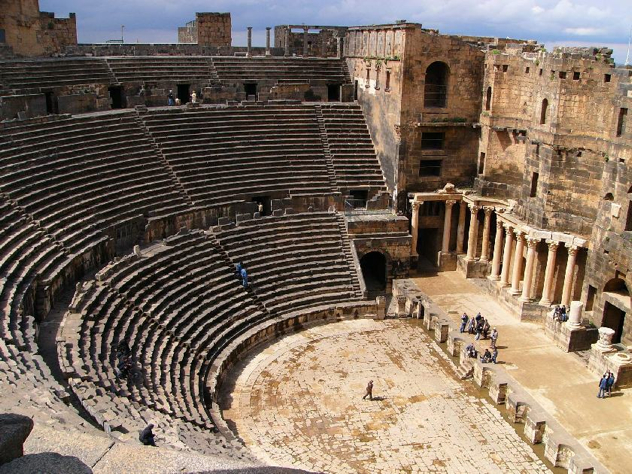 Bosra is an ancient city located in modern-day Syria, just south of Damascus. It is one of the oldest cities on Earth, mentioned in the fourteenth century B.C. by Egyptian hieroglyphs. The city was conquered by the Romans in A.D. 106, and made the capital of Roman Arabia.
Bosra is an ancient city located in modern-day Syria, just south of Damascus. It is one of the oldest cities on Earth, mentioned in the fourteenth century B.C. by Egyptian hieroglyphs. The city was conquered by the Romans in A.D. 106, and made the capital of Roman Arabia.
The Theater of Bosra was built soon afterwards, seating up to 15,000 people. Because a fortress was built around the theater by the Ayyubid Dynasty, it is now one of the best preserved Roman theaters in the world. It has amazing acoustics, a three-storey-high proscenium, and thirty-five rows of seating.
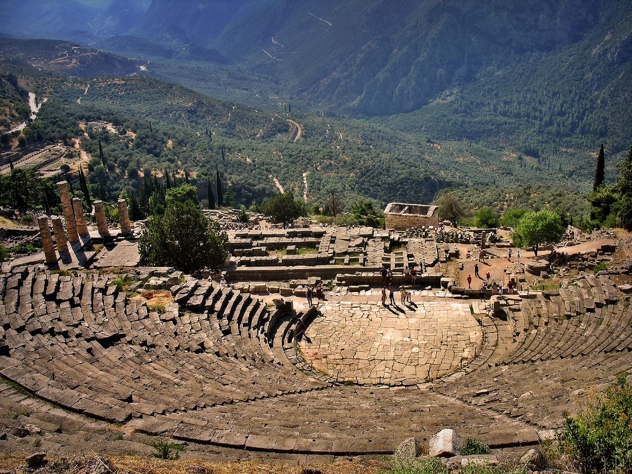 Delphi, as many people know already, was one of the most important sites in Ancient Greek religion, home to the sanctuary and oracle of Apollo. The shrine to Apollo at Delphi was dedicated in the eighth century B.C., and the site played an important role in the Pythian Games. Important architectural pieces of Delphi today include the Temple of Apollo, the Treasury of the Athenians, the stadium, and—which is our concern—the theater.
Delphi, as many people know already, was one of the most important sites in Ancient Greek religion, home to the sanctuary and oracle of Apollo. The shrine to Apollo at Delphi was dedicated in the eighth century B.C., and the site played an important role in the Pythian Games. Important architectural pieces of Delphi today include the Temple of Apollo, the Treasury of the Athenians, the stadium, and—which is our concern—the theater.
The ancient theater of Delphi was built on a hill, giving spectators a view of the entire sanctuary and the spectacular landscape surrounding it. It was originally built in the fourth century B.C., and could seat five thousand spectators. Although excavated and restored, the theater is in a poor condition; the cavea has subsided, the limestone blocks are cracking and flaking, and many of its architectural features remain scattered throughout the area.
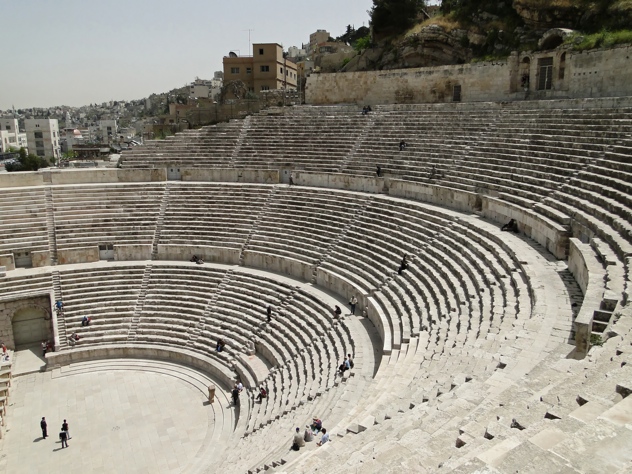
The most impressive monument of Jordan to this day is probably the theater, which was built during the reign of Antoninus Pius, and could hold six thousand people. The theater and odeon were on two sides of a colonnaded forum, of which only a small part remains today. These originally stood beside a stream and a major road, the Decumanus Maximus; the stream is now in an underground culvert and the road has long since been built over. A triple-arched gate that once stood to the north of the forum has also disappeared; it was the entrance to the processional stairway up to the citadel, and was mentioned by travelers as late as the 1900s.
In 1948, the theater provided a temporary safe haven for thousands of Palestinian refugees fleeing their homes in what became Israel. Within two weeks, Amman’s population nearly doubled.
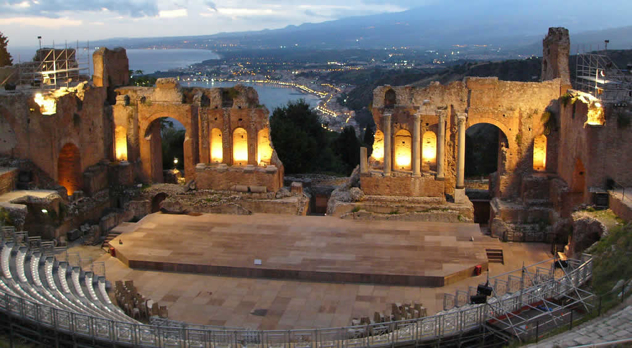 Taormina was a Greek colony on the east coast of the island of Sicily. The theater there was built by the Greeks in the second century B.C. It commands a fantastic view of all the beautiful places in the vicinity: Etna, the Bay of Naxos, Castelmola, and the crystal-clear Mediterranean.
Taormina was a Greek colony on the east coast of the island of Sicily. The theater there was built by the Greeks in the second century B.C. It commands a fantastic view of all the beautiful places in the vicinity: Etna, the Bay of Naxos, Castelmola, and the crystal-clear Mediterranean.
The theater was renovated and extended by the Romans, and today it is one of the largest ancient theaters in Sicily, second only to the one in Syracuse. This wonderful monument is now the seat of Taormina Arte, the International Film, Theater, and Dance Festival.
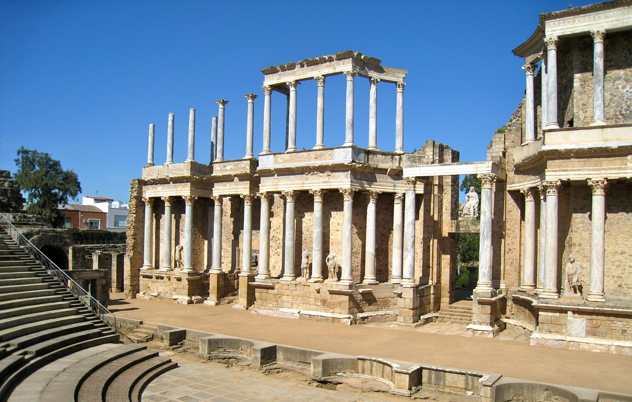
Mérida has a quite a few notable buildings, but the theater—sponsored by Consul Marcus Agrippa—is undoubtedly the most significant in the city, and perhaps through the whole Iberian Peninsula.
It’s a good example of classic Roman theater design. It features three horizontal seating sections, which corresponded to the social class of the spectators. It is estimated that the capacity of the theater was about five and a half thousand spectators.
In later centuries, the theater underwent several restorations which introduced new architectural elements and decorations. The structure was restored again in the 1970s, and has remained in its current state ever since. It still serves today as a place of performance, thanks to the celebration of a yearly festival of classical theater.
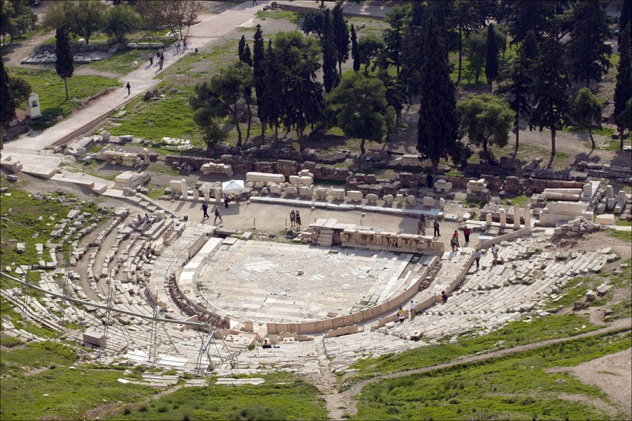
The Theater of Dionysus, which lies practically in the shadow of the Acropolis, is believed to be the most ancient theater in the world.
During the Classical era, Athenian drama was performed here during the celebration of the Great Dionyssia, one of the major religious festivals of the city.
Believed to have been built by descendants of the tyrant Peisistratos, it has seen many subsequent alterations and expansions, meaning that its architectural evolution remains a mystery. Today’s remnants derive from the late Roman period of the theater, with only a few rows of benches dating from its Classical Greek period.
An effort is currently underway to restore the ancient theater using fragments of the original Corinthian stone which have been scattered throughout the site.
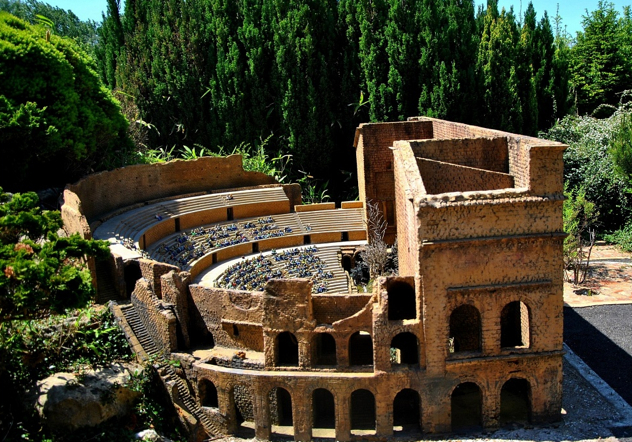
Originally built under Emperor Augustus in the first century A.D., the Roman theater of Orange was closed by official edict in 391 A.D., due to the Christian Church’s opposition to what it regarded as uncivilized spectacles.
The ancient theater was restored in the nineteenth century, and today it is home to the Chorégies d’Orange, a summer opera festival. The free audio guide provides visitors with interesting information about the shows and social life in the Provencal city during Roman times.
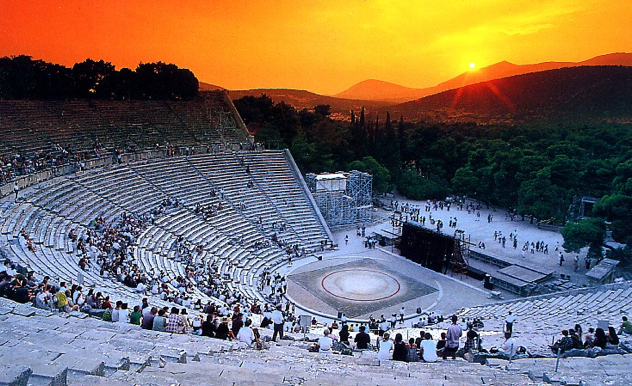
The theater of Epidaurus is undoubtedly the most famous and best-preserved ancient theater in the world—many people would expect it to rank as number one in this list.
It functioned as both the religious and political centre of Epidaurus, a city-state of rather minor importance which lived under the shadow of more powerful hubs like Corinth, Sparta, and Athens. The excavations, which began in 1880 and were completed along with restorations in the twentieth century, revealed the most perfect sample of ancient Greek theater.
It has fifty-five rows of seats, which are divided into twelve tiers at the lower landing and twenty-two on the upper one, giving the theater a capacity of more than twenty thousand viewers. The legendary acoustics of the theater has long been the source of academic and amateur speculation; some theories suggest that prevailing winds carried sounds or masks amplified voices, while others say that the secret lies in the design of the seats. No theory has been entirely proven, even after decades of research.
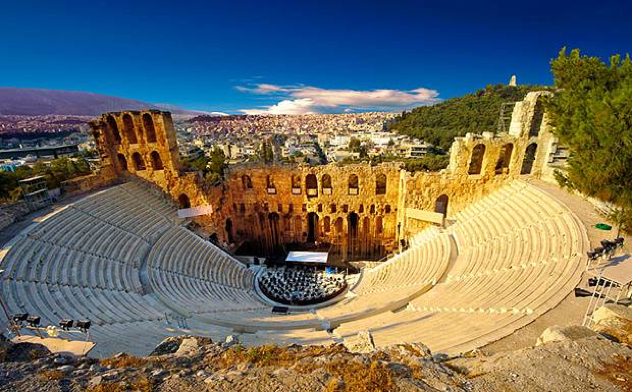
If this list was based only on cultural and historical impact, then Epidaurus would get the number one spot without question—but since we’re also taking into account its unique story and location, the Odeon of Herodes Atticus gets the nod instead.
Carved into the southern slope of the Athenian Acropolis, the odeon was built in 161 A.D. by Herodes Atticus in memory of his wife, so it’s foremost a memorial which also happened to function as a theater. It’s very possible that Herodes was the richest Athenian at the time. Though he was Greek in blood, he was an honored and privileged Roman citizen.
His vast wealth and education (he was a philosopher, sophist, and rhetorician) made him very popular, even among the royal Roman families. It is said that he was also the teacher of two Roman emperors: Lucius Verus and Marcus Aurelius. He lived a distinctly Roman lifestyle, and married a young and very beautiful Roman woman named Rigillia, who unfortunately died while she was still quite young.
The mourning of Herodes Atticus was so unbearable that he painted every wall and curtain of his house black and refused to leave it for a whole year. When he finally got over his depression, he made various dedications to the memory of his wife. One of them was a monument right under the Parthenon, which he first called “The Odeon of Rigilla” after his wife, but which he then rather selfishly renamed “The Odeon of Herodes Atticus.”
Theodoros II is a collector of experiences and a law graduate. He loves History, Sci-Fi culture, European politics, and exploring the worlds of hidden knowledge. His ideal trip in an alternative world would be to the lost city of Atlantis. His biggest passions include writing, photography, and music. You can view his photostream here.








